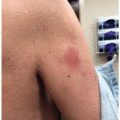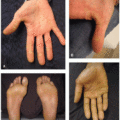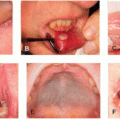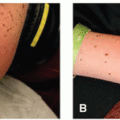Bleomycin
Jasmine Rana
Bernice Y. Kwong
A fermentation product of Streptococcus verticillus, bleomycin exerts a cytotoxic effect on replicating cells by inducing DNA double strand breaks. Bleomycin is administered systemically (IV and IM) for numerous malignancies, as an intrapleural injection for malignant pleural effusions, and off-label as a cutaneous intralesional injection for cutaneous metastases, Kaposi sarcoma, keloids/hypertrophic scars, keratinocyte carcinomas, vascular anomalies, and warts. Lung and skin tissue have relatively low concentrations of bleomycin hydrolase, a metabolizing enzyme, predisposing to a higher rate of lung and skin toxicities.1
REACTIONS AFTER INTRALESIONAL THERAPY
Transient pain and local erythema, swelling, burning, blistering, or tissue necrosis can occur with intralesional bleomycin. Nail dystrophy and nail hyperpigmentation may occur with periungual intralesional therapy. Rarely, intralesional use can cause more widespread reactions seen with systemic therapy, including flagellate hyperpigmentation, scleroderma, or Raynaud syndrome.2
REACTIONS AFTER SYSTEMIC THERAPY
Up to 50% of patients receiving systemic bleomycin therapy may develop adverse mucocutaneous reactions, including alopecia, flagellate (aka “scratch”) dermatitis (Figure 27.1) with resultant hyperpigmentation (Figure 27.2), nail dystrophy, neutrophilic eccrine hidradenitis, pruritus, stomatitis, and rarely, Raynaud syndrome, gangrene, and scleroderma-like skin changes. Skin toxicity is generally dose dependent, usually occurring after the second or third weekly treatment (after 150-300 units of bleomycin).3,4
Stay updated, free articles. Join our Telegram channel

Full access? Get Clinical Tree







